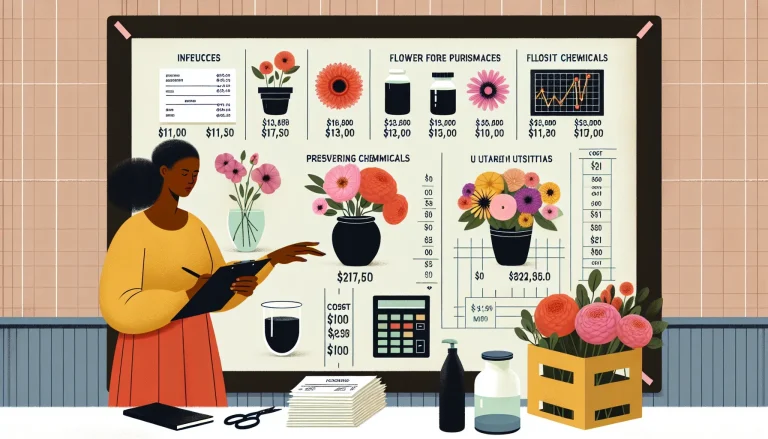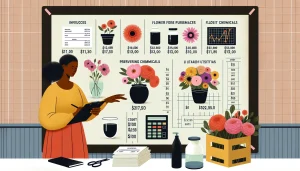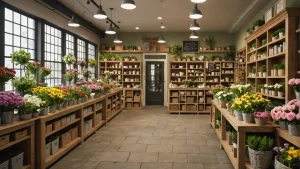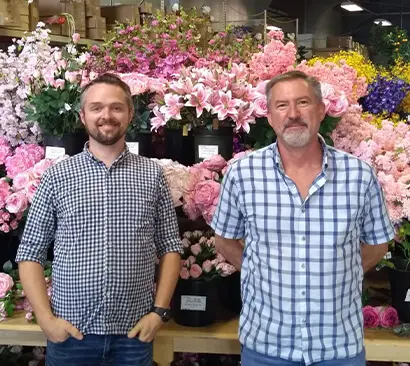Envisage a fine artist: every intricate brush stroke is plotted out in advance, blending colors meticulously until the final masterpiece emerges. However, instead of oil paints and canvas, your medium is petals, roses, and leaves. Welcome to the realm of floristry – a craft as delicate as the blooms it revolves around, but with costs as formidable as the thorniest rose bush.
Consider this: every lush bouquet or elegant centerpiece is a balancing act – a synergy of artful design and clever budgeting. At first glance, these two seem incompatible. Like the artist who needs expensive paints and rare brushes, the florist finds real financial investment behind every piece of greenery and each exotic bloom. Succinctly, we unravel this intricacy, shedding light on the practical budgeting needs lurking behind the floral splendor in your local florist shop. An enlightening journey awaits, blooming with unexpected insights into the business side of floristry.

Metrobi is transforming flower deliveries
Specialized solutions for flower businesses:
- Flower-trained drivers
- Proper handling equipment
- Peak day delivery support
- 23% average cost reduction

Lower your delivery costs by 23%
How we reduce costs:
- No delivery vehicle expenses
- Optimized local routes
- Pay-per-delivery model
- Average 23% delivery cost reduction
Unveiling the Real Costs: Florist Budget
Starting a florist business is no small endeavor and the costs linked to that can be substantial. A significant chunk of the initial investment goes into securing the right location. Whether it’s a brick-and-mortar storefront or an online store, each has its own set of considerations and expenses. For physical locations, that includes rent, utilities, renovations, and displays. Similarly, for online platforms, there will be costs for website development, hosting, and digital marketing.
You’ll also need to invest in equipment suitable for a florist shop. This includes refrigeration to keep flowers fresh, display cases, work tables, and also some general office equipment. Then there’s your initial inventory – the flowers, vases, ribbons, and all the other items that go into your creations. This will depend on the size of your shop and the variety of products you plan to offer whether it is a floral arrangement, bridesmaid bouquet, bridal bouquets, or wedding flowers, since they generally form a large portion of your startup expenses.
Hidden Costs: Bridal Bouquet and Wedding Flowers Cost Considerations
Beyond the conspicuous costs are a myriad of ‘hidden’ costs that might escape your initial calculations. Getting your entrepreneur permit, the business license, registering your business name – these administrative costs are sometimes glossed over. Insurance, a crucial safeguard, can be a significant annual cost depending again on location, size of business, and other risk factors.
Professional services are another overlooked cost. The expertise of accountants, solicitors, and business consultants can prove indispensable when navigating startup pitfalls. Depending on the complexity of your operation, you may also need to invest in specialized florist software to manage orders, bookings, and deliveries. Remember, these aren’t just one-time costs. Some, like professional services or software subscriptions, can recur and should be factored into your annual budget.
When planning your wedding day, consider the variety of costs associated with becoming your own wedding florist. For those looking to enhance their floral delivery capabilities, investing in a reliable logistics partner can make a significant difference. Consider exploring services like a same-day courier, which can ensure your floral creations arrive fresh and on schedule. For more details about effective delivery solutions, check out Metrobi’s Baltimore same-day courier service that can cater to your needs.
The cost of wedding flowers, from the bridal bouquet to bridesmaids bouquets and flower petals for the flower child, can vary depending on your wedding date, wedding style, and the level of elaborate designs you desire.
An experienced wedding florist can help you decorate your wedding ceremony and venues while advising on inexpensive flowers that match your floral budgets.
Remember, the cost of wedding flowers can fluctuate, so it’s essential to discuss all options and preferences well in advance to ensure your big day looks as beautiful as envisioned without exceeding financial boundaries.
For those in need of timely deliveries, leveraging a reliable service can be immeasurable. Discover how a dependable same-day courier service in Sacramento can facilitate smooth logistics for your floral business, ensuring arrangements arrive fresh and on time for your customers’ special occasions.
Keeping the Blooms Alive: Flower Shop Operating Expenses
Recurring Costs: Rent, Utilities, and More
Florist businesses thrive in locations with high pedestrian traffic, which often come with higher rents. A crucial part of the flower shop budget includes land cost, rent, or if you’ve dared to buy a property, the ongoing mortgage repayments. Utilities such as water and electricity also play a substantial part in keeping the blooms lively, and those bills stack up.
Costs of Setting Up Shop 🏠
The financial commitment to rent a bakery space can vary greatly, illustrating the significant impact of location on cost. Monthly rent for bakery spaces can range from $2,000 to $6,000. Similarly, utility expenses also vary widely depending on factors such as location, store size, and cooler usage, with estimates between $500 and $1,500 monthly. Proper budgeting for these expenses is essential for the successful operation of a bakery.
Employees form the lifeblood of any business, and flower shops are no different. Salaries, insurance, and pension contributions constitute another chunk of your operating costs. From knowledgeable florists creating beautiful arrangements to delivery personnel ensuring these arrangements reach customers on time – their efforts cost money big day. Invest in your team to enhance the efficiency of your floral delivery operations, making sure your clients receive their blooms promptly and with care.
Florist Career Ladder 🌼
- Entry-Level (Floral Assistant): Responsible for shop upkeep and simple tasks. Prepares materials for flower arrangements. Earns roughly $10 - $14 per hour.
- Floral Designer: Designs and assembles flower arrangements and bouquets, potentially needing design certifications. Salary ranges from $14 - $18 per hour.
- Lead Floral Designer: Manages design team, handles complex arrangements, and oversees inventory. Advanced certifications may be required. Salaries span $18 - $22 per hour.
- Shop Manager: Manages daily store operations, supervises staff, and ensures customer satisfaction. Experience in retail necessary. Typically earns $20 - $25 per hour.
Inventory Management: The Cost of Freshness
Fresh flowers are perishable. Unlike other retail stocks, flower inventories can wilt and lose value within a week. Thus, proper inventory management becomes a vital component of a florist’s budget and floral expenses.
A diverse range of species is a must for a vibrant flower shop. Purchasing from wholesalers helps keep costs low. Additionally, seasonal availability affects the costs of certain flowers. Anticipating these changes and managing purchases accordingly is a necessary dance.
Storage is another important consideration. Some blooms require refrigeration, adding to the utility costs, while others call for specific humidity or lighting conditions. Ensuring these needs are met is key to preventing costly stock losses.
Florist businesses also need packaging materials – wrapping papers, ribbons, and vases. Fluttering around the store, these seemingly minor costs can sneak up on a budget.
Ultimately, the real cost behind the blooms lies in the day-to-day operations of keeping a flower shop alive and vibrant. It’s a juggling act – a test of business acumen and a love affair with the trade. It’s an investment, not merely a financial one but an emotional and mental feat too.
Securing Your Future: Financial Planning for Florists and Bridal Bouquets
Budgeting Basics: Allocating Your Resources
Running a profitable enterprise requires shrewd resource allocation – from purchasing appealing flowers to maintaining a comfortable space for customers, every dime matters. It begins with understanding your cash flow. Identify and quantify keeping costs and other costs – rent, worker salaries, utilities, and all dimensions of running your shop. Understanding the nuances of the flower shop’s financial health is key – from skilled buying to efficient sales, every aspect of the floral business’s operations contributes to success.
When planning for a wedding, understanding the costs associated with wedding flowers is crucial for both the bridal party and the florist.
Bridal bouquets, bridesmaid bouquets, altar flowers, and decorations for cocktail tables can add a significant amount to the overall wedding budget.
The average cost of wedding flowers varies depending on the wedding location, date, and style, but it’s essential to incorporate all floral costs, from personal flowers to elaborate bouquets, into the wedding floral budget. To save money, couples can opt for less expensive flowers like baby’s breath or consider more modest designs instead of elaborate ones. For florists operating in Austin, understanding how logistics can impact service delivery is crucial. Leveraging a dependable courier service in Austin can help ensure floral arrangements arrive fresh and on time, enhancing customer satisfaction and potentially increasing repeat business.
Working closely with a wedding planner or directly with the florist, couples should ensure they’re on the same page regarding the flower order to align with their total wedding budget and personal touch, avoiding surprises with wedding costs. This coordination helps manage the overall wedding planning process and keeps wedding expenses, including the sometimes pretty penny spent on the most expensive flowers, within reason.
Business Expenses for Florist
In a florist business, various expenses play a crucial role in determining profitability and success. Here are examples of common business expenses for florists based on the search results:
- Cost of Goods Sold (COGS): These are expenses directly related to creating the product or service, such as flowers, tape, zip ties, foam, and other materials used in floral arrangements.
- Inventory Expenses: Initial investments in vases, stands, arches, and other inventory items that will continue to generate revenue over time.
- Overhead Expenses: Fixed non-labor costs not directly related to creating products, including rent, utilities, insurance, and other operational expenses.
- Advertising & Marketing Costs: Essential for promoting the business attracting clients and being on trend. This includes expenses for advertisements, campaigns, and other marketing strategies.
- Labor Costs: Including payments to contractors, freelancers, hourly workers, or salaried employees. Labor charges can vary based on the type of work and payment structure.
- Equipment & Supply Expenses: Initial investments in equipment like refrigerators and display cases, along with supplies such as floral decor, containers, office stationery, and furniture.
- Retail Business Expenses: Startup costs like licensing, insurance, and employee expenses are foundational aspects of a florist business plan.
Next, scrutinize your revenue streams. Are in-store sales your main income source, or do you also offer services like wedding flower arrangements, reception flowers, or corporate events? Comparing your costs and earnings gives you a clearer image of how much you have at your disposal. Enhance your business model by considering our efficient floral delivery services, ensuring your creations reach their destinations looking fresh and fabulous, without delay.
Lastly, evaluate all expenses for improvement potential. Negotiating for better rental terms, altering opening hours to save on electricity, or leveraging social media for cost-effective marketing, every small change can add up to significant savings.
Contingency Planning: Preparing for the Unexpected For Your Wedding Flower Budget
In a business where precarious factors like weather and market fluctuations heavily impact costs and sales, a florist shop is no stranger to sudden financial storms. To operate smoothly during these problematic periods, having a contingency fund can be as essential as the flowers you sell.
Firstly, aim to set aside a minimum of three to six months’ worth of operating costs. This buffer can help you navigate through unexpected disruptions like supplier hikes, sudden equipment breakages, or local emergencies disrupting your regular cash flow. Restocking or replacing items quickly can make a massive difference in preventing revenue loss.
Secondly, revisit this fund regularly. As your costs shift, ensure your contingency plan matches your fluctuating needs. For instance, if you added refrigeration systems for preserving flowers, ensure your fund covers potential repair costs. Keeping your rescue package current will ensure you’re ready for whatever challenges come your way.
A florist shop is a pulsing ecosystem that needs careful financial nurturing. Incorporating robust budgeting and preparing for potential crises become instrumental in safeguarding your business’s bloom in all weather.
So, what’s the bottom line? Profitability surely must be more than jar counting. Let’s delve into the cracks and crevices of running a profitable florist business, beyond just managing costs. Businesses may navigate through similar financial waters, but each has its own story, and its profitability secret. As a florist, what’s yours?
The Bottom Line: Profitability of a Florist Business
Moving beyond flower sales can power up a florist business’ revenue potential. Many florists typically offer event design services, brimming with creativity and a unique floral touch. They stage weddings, corporate events, and other special occasions such as reception decor, and ceremony flowers, translating into a significant revenue stream. Discover the secrets to designing a layout for your flower shop that effectively showcases your diverse range of services and boosts your business’s income opportunities.
Workshops are also a popular revenue-generating move. With a wave of interest in DIY crafts, florists can launch workshops teaching flower arrangements, elaborate arrangements, terrarium making, and even plant care. These events can add value to your business proposition while introducing a fresh income flow. Some florists also diversify into retail sales, such as vases, planters, and gardening tools, providing a one-stop-shop for all flower enthusiast needs.
Profit Margins: Understanding Your Earnings
Profit margins are a florist business’ lifeline to sustainable success. It’s the difference between your revenue and the cost to produce that revenue, expressed as a percentage of the revenues. High profit margins are favorable, showing you’re operating efficiently and gaining maximum returns on each dollar of sales.
Profit Margin Calculation 📊
Calculate your net profit margin using the formula:
Net Profit Margin = (Net Profit / Revenue) x 100.
By understanding this key indicator, florists can track their financial viability and assess how each revenue stream and cost contributes to their profitability. This aids in making informed decisions, from choosing suppliers to investing in growth opportunities.
Profit margins also provide a comparative tool — they give you a benchmark to assess how you’re faring against industry standards or competitors. They help pinpoint aspects of your operations that require improvement for greater financial solidity.
Profit Margins In Practice
Success in the floristry industry comes from effectively managing your profit margins despite changing market dynamics. For florists, factors such as the fluctuating costs of flowers depending on the season, transport costs, equipment, and labor expenses can eat into profit margins. Effective cost management, creative pricing strategies, and high-value, diverse revenue streams can help remedy this, and nurture a flourishing enterprise.
Securing Your Future: Financial Planning for Florists
Consistency in profitability is just a piece of the puzzle when it comes to a sustainable florist business. To secure your future as a florist and ensure the long-term success of your business, in-depth financial planning cannot be bypassed.
Long-Term Financial Goals: Planning for Growth
The measurement of success of a business isn’t solely based on its ability to remain afloat. To truly thrive in the floral industry, aspirations of growth and expansion should be constantly at the forefront of business operations.
Overlooking the roadmap to growth can cause stagnancy and limit opportunities. Embarking on this journey requires setting clear-cut, long-term financial goals. Whether it’s branching out to new locations or introducing a new range of exotic blossoms to your offerings, these goals will provide a clear direction on where to invest, how to allocate resources, and what steps to take for strategic expansion.
Consider drafting a five-year or ten-year growth plan⏤a detailed fiscal strategy outlining expected revenues, potential costs, and projected profits. To create a realistic plan, evaluate past and present financial performances, identify potential risks and opportunities, and factor in market trends in the floristry business.
Remember, long-term financial planning not only drives growth but also offers stability in tumultuous times. Allocate a portion of your earnings for contingency plans to combat unseen mishaps and protect your business from undue financial distress.
Growth Plans for a Florist in the USA
The floral industry is competitive, but there's still room for growth with a well-defined strategy. Here are some ideas:
- Specialization: Cater to a specific niche like wedding flowers, corporate events, sympathy arrangements, or exotic blooms.
- E-commerce Integration: Offer online ordering and delivery, making it convenient for customers to buy flowers remotely.
- Subscription Services: Create flower subscription boxes for recurring revenue and customer loyalty.
- Partnerships: Collaborate with event planners, wedding venues, or local businesses to offer bundled services.
- Social Media Marketing: Showcase your floral arrangements and connect with customers on platforms like Instagram and Pinterest.
- Workshops & Events: Host flower arranging workshops or participate in local farmers' markets to gain visibility and customer engagement.
- Sustainability Focus: Use eco-friendly packaging and source flowers from local growers to appeal to environmentally conscious customers.
Market Trends for Florists in the USA
Here are some key market trends to consider:
- Growing Online Sales: Online flower purchases are increasing, so having a strong online presence is crucial.
- Demand for Unique & Personalized Arrangements: Customers are looking for more unique and personalized floral arrangements.
- Experience Focus: People are increasingly interested in experiences, so consider offering flower-arranging workshops or themed events.
- Local & Sustainable Sourcing: Consumers are showing a preference for locally sourced and sustainable flowers.
- Convenience & Subscription Services: Subscription boxes and same-day delivery options are gaining popularity.
Retirement Planning: Securing Your Future
Contrary to popular belief, retirement planning isn’t just for nine-to-five job holders, but also for small business owners, who often overlook its importance. A well-devised retirement plan is not an unattended savings account but an active fund growing in proportion to your business.
Running a small business can be hugely rewarding but, without a retirement plan in place, one day, your business may close, and you may be left with few financial resources. Proactive retirement planning ensures that you enjoy the fruits of your hard work as you age.
Contemplate a retirement savings strategy tied into your business framework. Options can range from a SIMPLE IRA to a Solo 401(k). An experienced financial advisor can guide you on the best path, tailored to your current earnings and future retirement needs.
Remember, investing in your business’s prosperity is as vital as investing in your future.
Wrapping Up: The Importance of a Florist Budget
It’s without a doubt that budgeting is the backbone of any flourishing business. Particularly for a florist business, effective budgeting ensures you not only keep the operations afloat but also advance toward your financial goals.
One out of four businesses with poor fiscal management often hit a financial snarl leading to bankruptcy or closure. On the other hand, a carefully planned budget allows for prioritizing resources, managing cash flow, and forecasting potential financial challenges, stability, and growth.
At the core, budgeting is essentially financial planning. It allows for strategic allocation of resources, ensuring every dollar is steered towards generating more profit. For a florist business, this could mean finding cost-effective suppliers, investing in eco-friendly packaging, or even saving to purchase a much-needed delivery van. Understanding budget allocation, sourcing economic supplies, and planning investments – these are fundamental aspects of florist business management that contribute to its success.
Florist Business Insights in the U.S. 🌸
- Average Annual Income: Approximately $51,160.
- Gross Profit Margin: Typically ranges from 50% to 70%.
- Inventory Turnover: Usually between 4 to 6 times annually.
- Average Revenue per Transaction: Generally falls between $50 to $100.
Key Expenses for Florists 💸
- Inventory Cost: Major expenditure for purchasing flowers, plants, and materials.
- Rent and Utilities: Essential operating costs for maintaining a floral business space.
- Labor Costs: Crucial for paying employees, whether contract, freelance, or salaried.
- Equipment & Supplies: Initial and ongoing investments for refrigerators, display cases, and other necessary supplies.
Next Steps: Implementing Your Budget
Now, the understanding of the budget’s vital role is only one part of the equation; actual implementation is another. Here’s an action plan to get your budget off the ground.
- Start by clearly outlining your sources of income and listing all business expenses. A detailed revenue and expenditure list forms the essence of financial planning.
- Determine fixed costs such as rent, staff salaries, utilities, and insurance. For variable costs, hone in on things like flowers, vases, packaging, or marketing expenses.
- After calculating your expenses, subtract this from the income and allocate the remainder strategically to your immediate and long-term business goals.
- Monthly budget reviews are a sensible habit. These reviews help track the progress and make necessary adjustments, ensuring the business stays within the budget confines and profits.
- Lastly, don’t hesitate to consult with a financial advisor. A professional viewpoint can help refine your budgeting methods, ensuring more efficiency and accuracy.
With these steps in mind, your florist business stands a much higher chance of sailing smoothly amidst the tumultuous financial tides of the business world.
Petal to the Metal: Money Matters Behind the Beauty
Floristry is more than mere blooms; it’s as much a business with crucial costs like investment in quality seeds, ongoing maintenance equipment, and a proficient workforce. The real expenditure lies not just in the visible results but in the consistent efforts behind them.
You’ve spent time learning about these intricate details because they matter. Understanding the depths of the real costs behind the blooms helps you make better budgeting decisions, making your florist’s business more sustainable and profitable.
Don’t stop here. Dive deeper. Revisit your total budget, and identify where your money is going. Make sure it is invested in the right areas, ensuring growth and enrichment for your business. More importantly, this article equips you for meaningful conversations with suppliers, partners, and customers.
Have you ever had to reprioritize your overall budget after considering these hidden expenses?
Remember, when it comes to running a successful florist business, you need both petals and pennies, each contributing to the beauty you create. Every dollar spent is a seed planted toward tomorrow’s blooms.




























